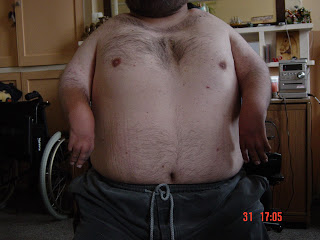But, like I said, it started innocently enough.
You see, he got me out off my chair today and had me on the mat doing stuff; such as crawling, some crunches and even a few sit ups. I know that for many of you that ain't much of a big deal, but for me it was like stepping out of a comfort zone. You see, while I'm on my wheelchair, I feel in control. Heck, I am in control. I am also more or less on the same level as everyone else. I can transfer from 'chair to bed, 'chair to couch and from the 'chair to the car and visa versa with little or no assistance, which is a good skill to have as that means no one does any lifting of me. Me getting on the floor, and onto a mat. Well, for me it was akin to impersonating a beached whale or one of them lazying sea lions and seals I see occasionally on the beach.
At least that's how I constantly saw myself, and avoided being on the floor in public. Besides, it also meant I needed help to get back up, and you can only imagine how many excuses I came up as to why I shouldn't be on the floor.
And yet, there I was on the floor, and doing stuff on the mat.
Ben had me crawling from one end of the mat to the other, backwards and forwards, army style. Seriously, made me slow down and concentrate on form and the like. I reckon that in due time I could stealthily crawl up and sneak up on someone, and scare the heck out of them. Yeap, definitely see myself doing it! In addition to that, the crunchies and sit-ups, Ben organised two boxes. One big one, and another medium sized one. Think of steps really. The goal here was for me to make my way up onto them, and sit up. Well, I gave it my best. The hardest was trying to get my legs to cooperate, but I managed to "flop" (seriously, it was an honest good looking flop too! :-P) my left leg over the right one, and turn around while holding all my weight on my arms. I completely turned, and then started to bend my right knee and transfer some of my weight onto it while I endeavoured to straighten my arms out and support myself with my hands. I put everything, but my right knee buckled and went numb on me. I tried to move up, but nothing. My leg wasn't budging, it didn't want to hold. No amount of verbal abuse from myself or determination could make me go any further. But you know what, somewhere around there I realised that I crossed that line. I achieved something.
Yes, I may have not gotten all the way up to the bigger box, but I achieved far more physical movement in that one exercise than any other time since the doctors gave me a motorised wheelchair when I came to New Zealand when I was like seven or eight. Not only that, I did it. I ignored my "physical limitations" and focused on what I could do, and I could do far more then I thought I could do. It was the most refreshing and emotionally charged realisation that I have ever experienced, and the fact that I pushed beyond what I thought I could do only made me want more.
I want more. Really, I do.
I want to do this, my original goal of competiting in wheelchair bodybuilding.
I want to make my way up that step. Heck, even a flight of the darn things, and I want to stand for as long as I can. I want to walk, run, jump and do what everyone else around me at the gym takes for granted.
I know that it will be a hard journey, and that my body will probably cave in now and then, but it's just a matter of working at it. Just got to do it, improve on what I can and do better next time.
And I will kick some major butt along the way, mine predominantly, but it'll be kicking butt nonetheless. I will do so because I have the likes of Ben, my personal trainer Cody, my family and friends at my side and supporting me through thick and thin.
I'll leave you with this awesome song by Sir Elton John...





